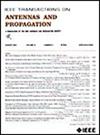On the Synthesis of Null-Scanning Leaky-Wave Antennas (NSLWAs) for Millimeter-Wave Direction-Finding Applications
IF 4.6
1区 计算机科学
Q1 ENGINEERING, ELECTRICAL & ELECTRONIC
引用次数: 0
Abstract
The inborn spectral-spatial decomposition property of leaky-wave antennas (LWAs) makes them well-suitable for low-cost direction-finding (DF) applications. Conventional LWAs are characterized by a frequency-scanned directive beam, upon which the DF can be performed by searching the spectral peak of echo signals. In contrast, we study in this work a class of LWAs exhibiting frequency-scanned radiation null, i.e., null-scanning LWAs (NSLWAs), which can be exploited for DF via searching the relevant spectral null. This NSLWA consists of a pair of specially engineered LWA elements that work collaboratively to synthesize a radiation null along the scanning plane. The synthesis theories regarding how to model these LWA elements conforming to certain specifications and how to determine their excitation phases are systematically discussed. Also, a generalized design flow is summarized to facilitate practical developments of this emerging antenna class. A simple NSLWA example based on two typical microstrips combline LWA elements is constructed, simulated, and measured for case studies. Simulated and measured results are in good agreement, and both exhibit the desired characteristic of frequency-scanned radiation null. While the radiation/spectral null essentially has a larger steepness than the relevant peak, the NSLWAs may find greater potential than conventional LWAs in high-performance DF applications.毫米波测向用零扫描漏波天线的合成研究
漏波天线固有的频谱空间分解特性使其非常适合低成本的测向应用。传统lwa的特征是频率扫描的定向波束,在此基础上,可以通过搜索回波信号的频谱峰来进行DF。相反,我们研究了一类显示频率扫描辐射零的lwa,即零扫描lwa (nslwa),它可以通过搜索相关的频谱零来利用DF。该NSLWA由一对特殊设计的LWA元件组成,它们协同工作以沿扫描平面合成辐射零。系统地讨论了如何对这些符合一定规范的LWA元件进行建模和确定其激励相位的综合理论。此外,总结了一个通用的设计流程,以促进这种新兴天线类的实际发展。基于两个典型的微带组合LWA元素,构建了一个简单的NSLWA示例,进行了模拟和测量,用于案例研究。仿真结果与实测结果吻合良好,均表现出所期望的频率扫描辐射零特性。虽然辐射/光谱零值本质上比相关峰值具有更大的陡峭度,但在高性能DF应用中,NSLWAs可能比传统LWAs具有更大的潜力。
本文章由计算机程序翻译,如有差异,请以英文原文为准。
求助全文
约1分钟内获得全文
求助全文
来源期刊
CiteScore
10.40
自引率
28.10%
发文量
968
审稿时长
4.7 months
期刊介绍:
IEEE Transactions on Antennas and Propagation includes theoretical and experimental advances in antennas, including design and development, and in the propagation of electromagnetic waves, including scattering, diffraction, and interaction with continuous media; and applications pertaining to antennas and propagation, such as remote sensing, applied optics, and millimeter and submillimeter wave techniques

 求助内容:
求助内容: 应助结果提醒方式:
应助结果提醒方式:


